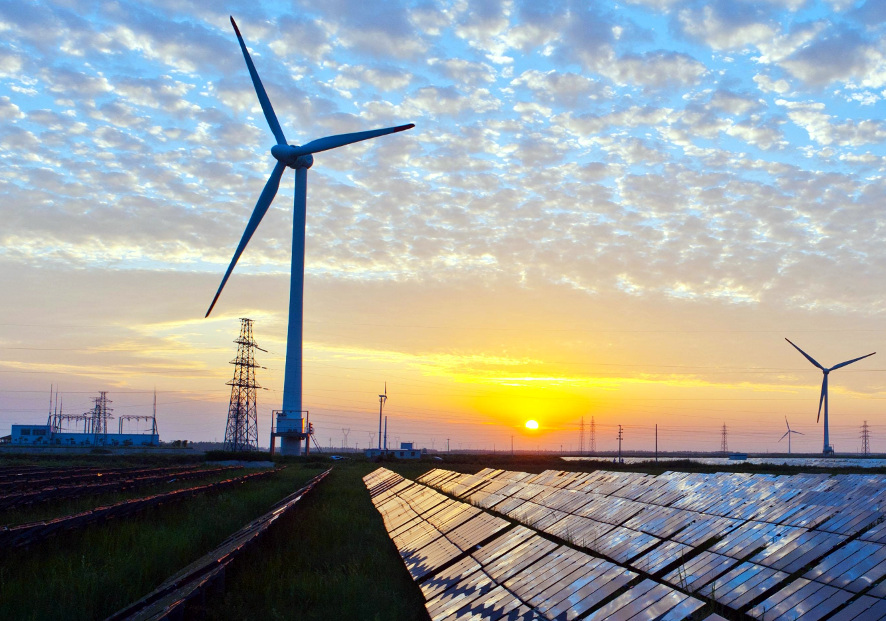What is renewable energy?
What type of renewable energy?
Why use renewable energy?
Using renewable energy at home
Our planet enriches us with renewable energy, so let’s make the most of it!
What is renewable energy?
There are different forms of energy, such as:
-
- traditional energies: gas, fuel oil, coal;
-
- electricity from nuclear or thermal power;
-
- and renewable energy, which is clean and comes from continuous and inexhaustible sources offered by our planet.
What type of renewable energy?
Renewable energy is an alternative solution to replace or complement other traditional energy sources.
5 types of energy are therefore available: solar – wind – hydraulic – geothermal, and biomass.
Solar energy
Solar energy comes, as its name suggests, from the sun. This energy can be usefully transformed into heat, electricity, or biomass.
This energy is mainly used by industry and private individuals.
It allows the development of photovoltaics, where sunlight is transformed into electrical energy through solar panels.
Wind energy

This energy is used to produce electricity through a generator.
Wind energy, therefore, uses the force of the wind.
Its disadvantage is that it generates a significant noise nuisance.
There are also mini wind turbines for individuals. These domestic wind turbines are installed on a roof or a slope.
Depending on the wind turbine’s size, the individual concerned can consume the electricity produced by it or resell it to an electricity supplier.
Hydraulic energy
It is an ancient process that allows the storage of large masses of water to transform into electricity. It is also called hydroelectricity.
It can be produced by hydroelectric power stations, some of which are fed by dams.
Geothermal energy
Geothermal power plants make use of the heat released from the earth’s core. The advantage of this energy is that it does not depend on climatic conditions or seasons.
Geothermal energy comes in two forms:
- low temperature to heat homes;
- high temperature, in this case, it is a means of producing electricity.
Biomass energy
This energy concerns wood, forest residues, organic and green waste, and biofuel or green gasoline.
This green gasoline is classified into two types:
- ethanol from wheat, corn, beet, sugar cane and ;
- biodiesel from rapeseed, sunflower, soya.
These biofuels are often blended with conventional fuels to limit the greenhouse effect.
As for wood, it has been used since the dawn of time for heating and cooking.
Why use renewable energy?
The various fossil fuels are not renewable energies and produce carbon dioxide (CO2) and other harmful gases such as methane.
The Energy and Climate Act updated the energy policy’s objectives to consider the previous years’ climate plan. It provides for the following purposes:
-
- carbon neutrality by 2050;
-
- a 40% reduction in the consumption of fossil fuels compared to 2012 by 2030;
To avoid an increase in the greenhouse effect and the destruction of the ozone layer, it is possible to change our habits by using renewable energy that is less dangerous for our environment.
It can also help us to reduce the cost of our electricity bills!
Using renewable energy at home
We pollute less by using renewable energies instead of fossil fuels (oil, natural gas).
Therefore, you can :
-
- consider building an energy-saving house;
-
- undertake energy-saving work in your current home;
-
- make energy savings in insulation;
-
- produce your electricity using solar or wind power;
-
- use energy-saving accessories such as energy-saving light bulbs;
-
- use water recuperators to save water and thus reduce your consumption bill.
The list is far from being exhaustive to use renewable energy at home or for transportation and consumption.
So that’s what you should know about renewable energy for sustainable development. Thank you for your reading, and thank you in advance for your efforts to add even more info in the comment section below to make it a hot topic.
